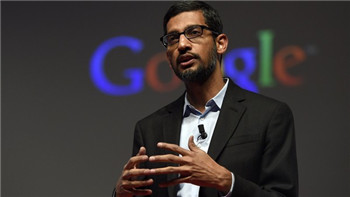(单词翻译:单击)

Sundar Pichai’s appointment this month as chief executive of the newly rejigged Google prompted happy outpourings across India. The US technology group will still be controlled by founders Larry Page and Sergey Brin. But Mr Pichai’s rise to become their most senior lieutenant seemed to confirm the considerable achievements of India’s global diaspora.
上月,桑德尔皮查伊(Sundar Pichai)被任命为刚刚重组的谷歌(Google)的首席执行官,这一消息在印度激起了一片欢腾。这家美国科技集团将仍由其创始人拉里椠奇(Larry Page)和谢尔盖布林(Sergey Brin)掌管,不过皮查伊晋升为二人最高级别的副手,似乎证实了世界各地的印度侨民取得的卓越成就。
Pride in eminent expatriates is common across developing economies. But it is especially warranted in India, whose émigrés have achieved great prominence in the US. Mr Pichai’s promotion follows a handful of others: Satya Nadella, for instance, who last year took the helm at Microsoft; or former Google executive Nikesh Arora, now heir presumptive at SoftBank, the Japanese telecoms group.
令各发展中经济体骄傲的杰出侨民屡见不鲜,但印度更有理由骄傲——印度侨民在美国取得了显赫的成就。早在皮查伊晋升前,已有几位印度人身居要职:比如去年接掌微软(Microsoft)的萨蒂亚纳德拉(Satya Nadella),以及前谷歌高管、现为日本电信集团软银(SoftBank)假定继承人的尼克什阿罗拉(Nikesh Arora)。
More interesting, though, are the wider accomplishments of Indian entrepreneurs in Silicon Valley.
然而,更有趣的是,印度企业家在硅谷取得了更为广泛的成就。
At first this looks counterintuitive. Indians have a strong reputation as software developers, dating back to the first wave who arrived armed with elite engineering degrees in the 1980s. But that same group has since gone on a less heralded journey, outpacing once-dominant communities from Taiwan and China, to become the US’s most technologically entrepreneurial immigrants as well.
起初,这似乎与人们的直觉相悖。自20世纪80年代第一批拥有名牌院校工程学学位的精英抵达美国起,印度人作为软件开发者一直声誉显赫。但人们没有料到的是,这批人还赶超了一度占据统治地位的台湾和中国大陆移民群体,成为了美国最具科技创业精神的移民。
Today the contest is not even close. Immigrants either founded or co-founded around four in 10 Silicon Valley businesses between 2006 and 2012, according to the Kauffman Foundation — itself a remarkable statistic. Of those immigrant-founded companies, however, roughly a third were launched by Indians. The next most successful group, the Chinese, accounted for 5 per cent.
如今这场比赛已经拉开了明显的差距。据考夫曼基金会(Kauffman Foundation)统计,2006年至2012年间,硅谷每10家企业中,有大约4家的创始人或联合创始人是外来移民。而这些移民创建的公司中,约有三分之一由印度人发起。紧随其后的群体是中国人,占比5%。
Indian immigrants in the US are numerous, highly educated and speak excellent English. This adds up to a powerful trio of traits that other foreign arrivals struggle to match, according to political scientist Devesh Kapur, co-author of a forthcoming book on the diaspora. As a result, Indians do well across corporate America, bagging top roles at blue-chip companies and Wall Street banks, and making Hinduism the country’s wealthiest religion per capita.
美国的印度移民数量庞大,教育程度高,说着流利的英语。政治学家德韦什愠湓尔(Devesh Kapur,他与人合著的关于外侨的书籍即将出版)表示,这三种强大的优势集于一身使其他外侨难以匹敌。因此,印度人在美国企业界的日子都过得不错,在蓝筹公司和华尔街的银行更是身居高位,还使印度教成为了美国人均最富裕的宗教。
Yet this alone does not explain why they prosper in the technology sector, a phenomenon with deeper roots in the experience of the early engineers who first moved to California. Back then, employment at established tech companies came easily. But those who tried to launch start-ups found life more difficult, struggling to raise venture capital in particular.
然而,仅仅这一点并不能解释为何印度人在科技业如此飞黄腾达,这一现象更深层的原因源于早年第一批移民加州的工程师。当时,想被知名科技公司雇佣十分容易。而那些试图创业的人却发现生活要艰难得多,想要筹集风险资本尤其困难。
The lesson drawn by these pioneers, says Vivek Wadhwa, entrepreneur and Stanford University fellow, was that you had to stick together. “The first crop of Indian entrepreneurs all had similar stories of being held back by a tech system dominated by white Americans,” he says. Those who succeeded, such as Vinod Khosla, co-founder of Sun Microsystems, became linchpins in a support system for their fellow nationals, ranging from formal business groups to ad hoc networks for mentoring and funding. “They decided they needed to help each other out.”
企业家、斯坦福大学(Stanford University)研究员维韦克瓦德瓦(Vivek Wadhwa)称,这些先驱总结的经验是,大家必须团结一心。“第一批印度创业者都有类似的经历——在由美国白人统治的科技系统被打压,”他说道。那些成功者,比如太阳计算机系统公司(Sun Microsystems)的联合创始人维诺德科斯拉(Vinod Khosla),在印度同胞的互助体系中起着关键作用。这个互助体系从正式的企业集团到临时的导师和融资网络一应俱全。“他们决定必须互相帮助才能脱颖而出。”
Nowadays, Indian executives are over-represented across Silicon Valley, especially at businesses that prize engineering talent, such as Google. But while the original need to break into the tech sector has passed, their habits of mutual support persists. Mr Pichai seems to embody this culture too, given the way colleagues describe him as technically brilliant, but also kind and helpful to others.
如今,硅谷的印度裔高管已经数不过来了,尤其是在像谷歌这样高度重视工程技术人才的企业。然而,尽管印度人不再需要像最初那样打入科技业,他们互帮互助的习惯仍然延续着。皮查伊身上似乎也体现着这种文化。同事口中的他不仅有技术才华,而且为人友善、乐于助人。
It might seem surprising that this kind of clubbing together was necessary. Silicon Valley is celebrated for its dense networks of funders and entrepreneurs. Evangelists portray the area as the ultimate open economic system; a freewheeling technological meritocracy, in which outsiders are welcome and good ideas rise to the top.
或许令人吃惊的是,这种“抱团”很有必要。硅谷以其密集的投资人和企业家人脉网络而著称。鼓吹者将这里描绘成终极开放经济体系——一个无拘无束的技术型精英管理体系。这里欢迎外来者,任何好点子都能受到高度重视。
That is at best a half-fiction. The tech sector is not always collegiate, as recent revelations about Amazon’s work practices made clear. The same point is driven home by the anxious founders and backbiting coders of hit HBO comedy Silicon Valley .
上面的描述往好了说也是半虚构的。硅谷的科技业并非总是学院式的——最近曝光的亚马逊(Amazon)内部工作风格将这点暴露无遗。HBO的热门喜剧《硅谷》(Silicon Valley)中焦虑的创业者和互相中伤的程序员也同样揭示了这一点。
Above all, successful innovators also tend to have the best contacts, opening closed doors to money and support. Those without access — foreigners, for instance, or women — must break into established networks or create others. And more than any other group of outsiders, it was the Indians who figured out that, to make it in start-up land, it helps to have a social network of your own.
最重要的是,成功的创新者往往也拥有最好的人脉,这就打开了原本紧闭的资金和支持的大门。那些没有门路的人——比如外国人或者女性——必须打入现有的人脉网络,或者创建新的网络。比起其他外来群体,印度人更明白这个道理——想在这片创业之地获得成功,最好建立属于自己的社交网络。


